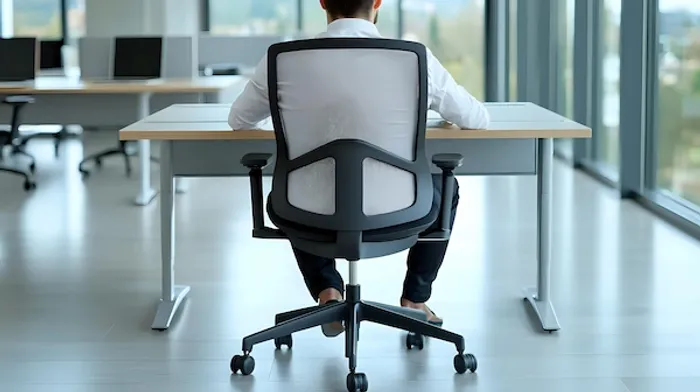The Ultimate Guide to Workplace Ergonomics: Boost Health & Productivity
Discover why ergonomics in the workplace is essential for health, comfort, and productivity. Learn practical setup tips, modern solutions for hybrid work, and proactive habits to prevent strain and injury.

Written by Dr. Mohammed Kamran
Reviewed by Dr. Dhankecha Mayank Dineshbhai MBBS
Last updated on 26th Sep, 2025

Introduction
In today's desk-bound world, the average person will spend over 80,000 hours at work. That’s a staggering amount of time spent in a chair, often in positions that can silently sabotage health. If you’ve ever ended a workday with a stiff neck, aching back, or sore wrists, you’ve experienced the direct consequence of poor workplace setup. This is where understanding the critical importance of ergonomics becomes a game-changer. Far from being a corporate buzzword, ergonomics is the science of designing the workplace to fit you, not the other way around. It’s about creating an environment that supports your body, enhances your comfort, and unlocks your productivity. This guide will explore why ergonomics is essential for both personal well-being and business success, with actionable steps to transform your workspace into a pillar of health.
What is Ergonomics? More Than Just a Good Chair
Many people hear "ergonomics" and picture an expensive office chair. While a good chair is part of it, ergonomics is a much broader and more profound concept. At its core, ergonomics (often called "human factors") is the scientific discipline concerned with understanding the interactions among humans and other elements of a system. In simple terms, it’s the practice of designing products, systems, and processes to optimise human well-being and overall system performance.
The Simple Science of Fitting the Job to the Person
Instead of forcing your body to contort to fit your desk, keyboard, and monitor, ergonomics adjusts those tools to your body’s natural, neutral posture. This "neutral posture" is where your joints are aligned, and muscles are relaxed, minimising stress and strain. When your workspace is ergonomically correct, you reduce the physical stress that can lead to Musculoskeletal Disorders (MSDs). Understanding this principle is the first step in appreciating the importance of ergonomics in daily life.
Consult Top Doctors for Personalised Advice
Why Ergonomics is Non-Negotiable: The Multifaceted Importance
Ergonomics extends far beyond simple comfort. It creates a ripple effect of positive outcomes for employees and organisations.
For Employee Health: Preventing Pain and Chronic Injury
The most immediate importance of ergonomics is protecting health. A poorly set up workstation is a major contributor to physical ailments.
Musculoskeletal Disorders (MSDs): The Primary Target
MSDs affect muscles, nerves, tendons, ligaments, joints, and spinal discs. Common examples include carpal tunnel syndrome, tendonitis, and lower back pain. According to the Occupational Safety and Health Administration (OSHA), work-related MSDs account for over 30% of all lost-time injuries and illnesses. Ergonomics reduces these risks by tackling repetitive motions, awkward postures, and excessive force.
Beyond the Physical: Reducing Eye Strain and Mental Fatigue
Proper monitor placement and lighting reduce digital eye strain, which causes headaches, dry eyes, and blurred vision. When you are physically comfortable, you are also less distracted by discomfort, improving focus and reducing mental fatigue. If persistent pain or numbness does not improve after workstation adjustments, it may be wise to consult a doctor online with Apollo24|7 to rule out underlying conditions.
For Business Success: The Tangible Return on Investment (ROI)
From a company perspective, ergonomics is a strategic investment with a clear return.
Skyrocketing Productivity and Work Quality
Comfortable employees work faster and make fewer mistakes. Ergonomic interventions have been shown to increase productivity by 10-25%.
Slashing Costs: Absenteeism and Presenteeism
MSDs drive absenteeism, and presenteeism is just as costly—where employees are present but underperforming due to pain. Ergonomics reduces both, ensuring staff are fully functional.
Boosting Morale and Talent Retention
Investing in ergonomics shows employees their well-being matters. This improves morale, loyalty, and talent retention. In today’s competitive market, this is a major differentiator.
Your Personal Ergonomic Workspace Assessment
Creating an ergonomic workspace doesn’t require specialist knowledge. The following areas are key to assess and adjust.
The Chair: Your Command Centre for Posture
Your chair is the foundation of posture. Adjust it so that your feet rest flat on the floor (or a footrest), thighs are parallel to the floor, and knees are level with your hips. The backrest should support the lower back, and armrests should allow shoulders to relax.
The Monitor: Positioning for a Healthy Neck and Eyes
Monitor setup is crucial for preventing neck strain and eye fatigue. Place the top of the screen at or just below eye level, an arm’s length away, and tilt it slightly backward to minimise glare.
The Keyboard and Mouse: Keeping Wrists in a Neutral Zone
Your keyboard and mouse should be positioned so elbows rest at a 90-110 degree angle and wrists stay straight. This reduces the risk of repetitive strain injuries.
The "Third Dimension": Lighting, Noise, and Movement
Environment plays a significant role in ergonomics. Ensure lighting is bright but not glaring, minimise noise distractions where possible, and remember that movement is essential—no posture is perfect if held for too long.
Ergonomics in the Modern World: Hybrid Work and Beyond
The shift to hybrid and remote work has made self-managed ergonomics essential.
Setting Up a Healthy Home Office on a Budget
You don’t need to spend heavily to improve ergonomics. Books can raise a monitor, a pillow can provide lumbar support, and regular breaks add vital movement. The key principles remain the same whether at home or in an office.
The Laptop Dilemma and Simple Solutions
Laptops tie screen and keyboard together, creating ergonomic conflicts. The solution is simple: use a separate keyboard and mouse, and raise the laptop on a stand or books so the screen is at eye level. This is one of the best investments remote workers can make.
Proactive Habits: Ergonomics is a Practice, Not a Preset
Even the best setup won’t help without healthy habits. The body is designed for movement, not long periods of stillness.
The Power of Microbreaks and the 20-20-20 Rule
Every 30 minutes, take a short break to stand, stretch, and move. For eye health, follow the 20-20-20 rule: every 20 minutes, look at something 20 feet away for 20 seconds.
Simple Stretches for the Desk-Bound Professional
Incorporating stretches throughout the day prevents stiffness. Neck tilts, shoulder rolls, wrist stretches, and back extensions keep circulation flowing and muscles relaxed.
Conclusion
The evidence is clear: neglecting ergonomics is costly for health and business. It is not a luxury but a cornerstone of a safe and effective workplace. By applying ergonomic principles—from adjusting a chair to building proactive habits—you invest in long-term health and performance. With small, consistent changes, you can end your day feeling energised instead of drained, focused instead of fatigued. Start with one adjustment today, and let it build towards lasting results for both your well-being and your career.
Consult Top General Practitioners
Consult Top General Practitioners

Dr. Mainak Baksi
General Practitioner
13 Years • MBBS , MD (MPH)
Howrah
Mainak Baksi Clinic, Howrah
(50+ Patients)

Dr. Siri Nallapu
General Practitioner
5 Years • MBBS
Hyderabad
Apollo 24|7 Clinic, Hyderabad

Dr. Vasanthasree Nair
General Practitioner
15 Years • MBBS
Angamaly
Apollo 24|7 Clinic - Kerala, Angamaly
(500+ Patients)

Dr. Shesham Srinidhi
General Practitioner
5 Years • MD(physician)
Hyderabad
Apollo 24|7 Clinic, Hyderabad
(150+ Patients)

Dr. Rajib Ghose
General Physician/ Internal Medicine Specialist
25 Years • MBBS
East Midnapore
VIVEKANANDA SEBA SADAN, East Midnapore
Consult Top Doctors for Personalised Advice

Dr. Mainak Baksi
General Practitioner
13 Years • MBBS , MD (MPH)
Howrah
Mainak Baksi Clinic, Howrah
(50+ Patients)

Dr. Siri Nallapu
General Practitioner
5 Years • MBBS
Hyderabad
Apollo 24|7 Clinic, Hyderabad

Dr. Vasanthasree Nair
General Practitioner
15 Years • MBBS
Angamaly
Apollo 24|7 Clinic - Kerala, Angamaly
(500+ Patients)

Dr. Shesham Srinidhi
General Practitioner
5 Years • MD(physician)
Hyderabad
Apollo 24|7 Clinic, Hyderabad
(150+ Patients)

Dr. Rajib Ghose
General Physician/ Internal Medicine Specialist
25 Years • MBBS
East Midnapore
VIVEKANANDA SEBA SADAN, East Midnapore
More articles from General Medical Consultation
Frequently Asked Questions
What is the most common ergonomic mistake people make at their desk?
The most common mistake is setting the monitor too low, which forces the neck forward and causes pain. The screen top should be at or just below eye level.
Are standing desks really better for you than sitting desks?
Standing desks are helpful but not a complete solution. The key is alternating between sitting and standing, as standing all day can also cause health issues.
How can I improve my ergonomics without buying expensive equipment?
Simple adjustments such as using books to raise your monitor, adding a rolled towel for lumbar support, and ensuring feet are flat on the floor can make a big difference.
What are the first signs of a work-related musculoskeletal disorder (MSD)?
Early symptoms include persistent pain, stiffness, numbness, tingling, swelling, and reduced mobility. Addressing workstation setup early helps prevent worsening.
How often should I take breaks from my computer?
Take a short break every 30 minutes to stretch and a longer break every 60-90 minutes for movement and rest.




